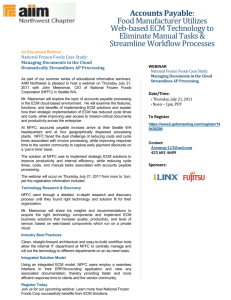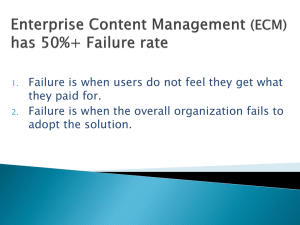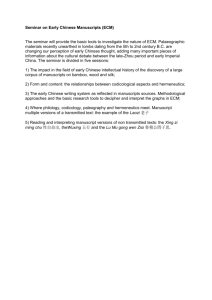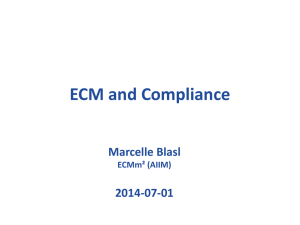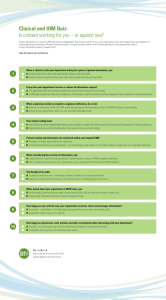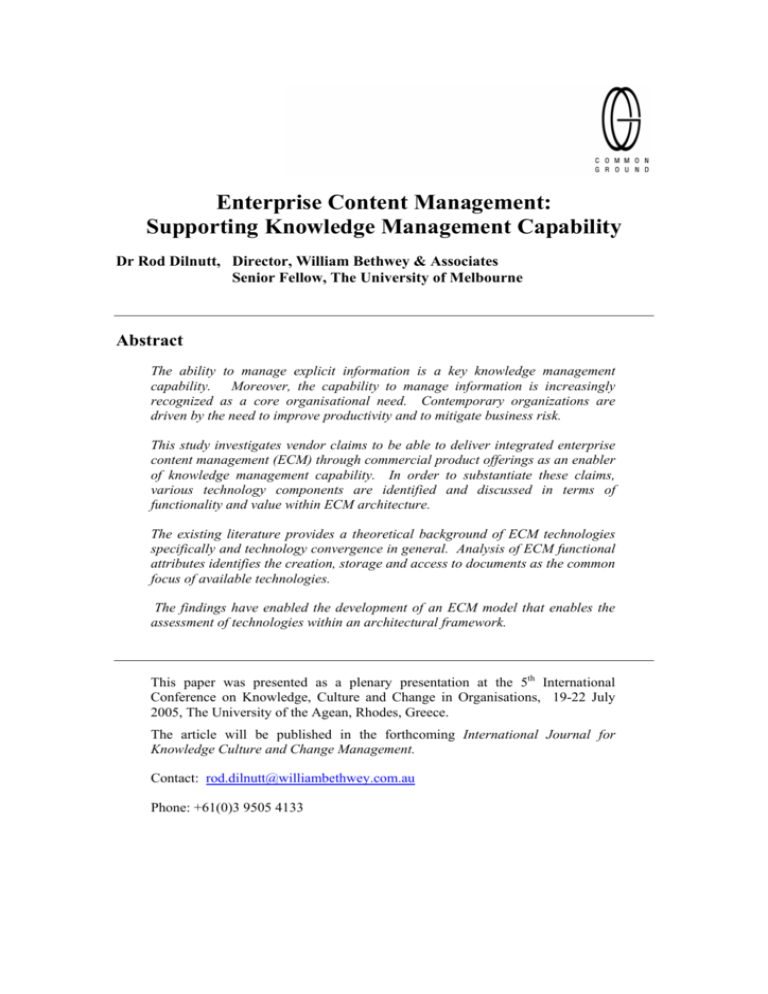
Enterprise Content Management:
Supporting Knowledge Management Capability
Dr Rod Dilnutt, Director, William Bethwey & Associates
Senior Fellow, The University of Melbourne
Abstract
The ability to manage explicit information is a key knowledge management
capability. Moreover, the capability to manage information is increasingly
recognized as a core organisational need. Contemporary organizations are
driven by the need to improve productivity and to mitigate business risk.
This study investigates vendor claims to be able to deliver integrated enterprise
content management (ECM) through commercial product offerings as an enabler
of knowledge management capability. In order to substantiate these claims,
various technology components are identified and discussed in terms of
functionality and value within ECM architecture.
The existing literature provides a theoretical background of ECM technologies
specifically and technology convergence in general. Analysis of ECM functional
attributes identifies the creation, storage and access to documents as the common
focus of available technologies.
The findings have enabled the development of an ECM model that enables the
assessment of technologies within an architectural framework.
This paper was presented as a plenary presentation at the 5th International
Conference on Knowledge, Culture and Change in Organisations, 19-22 July
2005, The University of the Agean, Rhodes, Greece.
The article will be published in the forthcoming International Journal for
Knowledge Culture and Change Management.
Contact: rod.dilnutt@williambethwey.com.au
Phone: +61(0)3 9505 4133
Enterprise Content Management:
Supporting Knowledge Management Capability
Introduction
Observations of product offerings in the commercial marketplace indicate that the term
Enterprise Content Management (ECM) is being increasingly used by technology vendors to
describe their software products. The vendor’s claim of being able to manage unstructured
information in the form of documents, web pages and drawings is a relatively recent
phenomenon (Rylatt, 2003; Asprey & Middleton, 2003; Gartner, 2004; Becerra-Fernadez et
al., 2004).
This study investigates vendor claims to be able to deliver ECM capability through their
product offerings. It is noted that academic research into technologies that deliver enterprise
wide capability has been significant, particularly in relation to Enterprise Resource Planning
and office based authoring and communication tools (Davenport, 2000; Koch, 2001; Luan &
Serban, 2002; Markus et. al., 2003).
If we accept that ECM is becoming an organisational capability then we need to understand
the business and technology architecture that enables the delivery of ECM. This paper
assesses candidate ECM components that would contribute to ECM and develops an ECM
architecture capability that supports Knowledge Management capability.
This study establishes an understanding of ECM as an enabler of knowledge management
capability. This is important as we need to understand and define what exactly is being
conveyed by the term ECM and what impact this has on existing information technology
infrastructures.
The convergence of technology as an ongoing phenomenon has previously been the subject
of academic investigation (Tinkler et. al., 1996; Dista, 2003; Asprey & Middleton, 2003;
Collins, 2004). The patterns of convergence, particularly in relation to Enterprise Resource
Planning systems as now mature technologies, can inform us of what we can potentially
expect as ECM vendors and technologies continue to evolve (Luan & Serban, 2002).
Enterprise Content Management and Knowledge Management
Davenport & Prusak (1998) discuss knowledge management as being beyond the
management of information captured in documents, databases and repositories. Knowledge
is described as a blend of experiences, values, context, insight and grounded information
(Davenport & Prusak, 1998). This view is widely supported in the literature relating to
knowledge management. Further, there is a common view that technology has a contribution
to make to knowledge management as a key enabling infrastructure (Leonard-Barton, 1995;
Nonaka, & Takeuchi, 1995; Stewart, 1997; Svieby, 1997; Boiset, 1998; Fahey, 1998; Hansen
et. al., 1999).
The emergence of Enterprise Content Management as an integrated approach to building
organisational capability enabling the management of explicit, documented information is an
important infrastructure supporting knowledge management practice.
For the purposes of this paper we will accept that knowledge management is concerned with
providing people with current and accurate information within the context of their roles
(Davenport & Prusak, 1998; Dilnutt, 2002). The effective management of document based
knowledge relies on technology infrastructures enabling people to create, store and access
documentation in a timely manner.
Enterprise Content Management: Supporting Knowledge Management Capability
Page 1
From a knowledge management perspective we must recognize that ECM or any other
technology is only able to provide management of explicit knowledge, i.e. written information.
Technology tools have a limited ability to address the need to manage tacit or people based
information which by nature is retained in the heads of employees.
At the organisational level Information Technology (IT) Architecture is the organisation of,
applications, data and infrastructure technologies. The business capabilities (Ross, 2003). It
is noted that the term (IT) architecture suffers from a lack of definition and sometimes is used
interchangeably with the term (IT) Infrastructure (Weill & Vitale, 2002). For the purposes of
this study the term architecture will be adopted to describe an integrated model of ECM
applications.
Method
Observations of the commercial marketplace provide the basis for concluding that there is a
general convergence of technology offerings relating to ECM. This study, conducted during
first half calendar year 2005, examines the academic and commercial literature relating to
technology convergence with particular attention being paid to technologies providing ECM
capability.
There are numerous product offerings in the ECM space. This investigation has focused on
the most prevalent of those offerings and is not intended to be an exhaustive evaluation of the
marketplace or of the products themselves.
Selection of products that have been included within the scope of this analysis was on the
basis of identified presence in the Australian marketplace. The products that have informed
this research are identified at appendix A to this report.
The data that has informed this research is drawn from three primary sources: existing
published literature, scrutiny of publicly available information sourced through product
documentation, industry journals and internet sites; and interview data (obtained from users
and product vendors). Analysis of the functional attributes of each product enabled the
identification of similarities and differentiating features of the products.
It is not the intention of this study to evaluate specific product offerings however, the
functional offerings of these technologies are assessed to determine how these fit into a
commonly applicable ECM architecture.
ECM Convergence
Observations of the commercial marketplace provide the basis for concluding that there is a
general convergence of technology offerings which supports ECM. The broad objectives of
ECM Architecture are to enable knowledge management capabilities which in turn support
business strategy. However, there is no common definition or model that clearly identifies
what would constitute an integrated ECM.
Gartner Group (2004) has recognised that this convergence is in its infancy and will take
several years to reach maturity. The positioning of vendors and the incidence of mergers and
acquisitions in this space reflects the industry’s recognition of the demand for simplified and
integrated product suites.
Predictions from industry research institutions including Gartner Group (2004), Delphi Group
(2004), Forrester (Bartels, 2004) and MetaGroup (Alvarez, 2002) are consistent in their
expectations of significant growth. The MetaGroup predicts that the ECM market will exceed
$US 10 billion in 2004 with more than 90% of ‘Global 2000’ companies having formalised
electronic record management policies and technologies in place by 2006. Similarly Gartner
Group (2004) predicts a fourfold expansion in the marketplace during the period 2002 – 2006.
Enterprise Content Management: Supporting Knowledge Management Capability
Page 2
It is observed that current vendors have built ECM capability based on their historical
strengths and are responding to business demands for integrated solutions to manage the
ever increasing volumes of documents found in contemporary organisations.
For example, the 2003 acquisition of Documentum by EMC provides integration of
established web based records, document management and workflow capability with longterm and high volume digital storage capacity. Vignette’s web content management capability
has been augmented by the addition of records and docoument management capability
throught the 2003 acquisition of Tower Technologies. In 1995 Hummingbird acquired the
records and document management capabilities of PC Docs.
Why is Convergence Occurring?
There are a number of factors that are creating the environment for technology convergence.
Rylatt (2003) identifies a number of trends that will impact knowledge management practice.
These trends include smarter knowledge platforms and a move towards the adoption of
common standards and protocols. Implicit in this discussion is the convergence of technology
and need for greater accessibility and availability of digitally based resources.
Examination of the academic literature augmented by the various marketing material offered
by the vendor community reveals that the benefits of ECM can be categorised under the
broad headings of compliance, efficiency, consistency, customer service and consolidation
(Luan & Serban, 2002; Asprey & Middleton, 2003).
Further, there is an increasing focus on corporate governance in the light of high profile
corporate transgressions which have been associated with inadequacies in control over
corporate records.
The absence of management discipline governing corporate information and records creates
significant business risk (Asprey & Middleton, 2003). Consider this quote: "It might be useful
to consider reminding the (Enron) engagement team of our document retention policy. It will
be helpful to make sure that we have complied with the policy. Let me know if you have any
questions" (Nancy Temple, in house Attorney, Arthur Andersen, 2001). In June 2002 Arthur
Andersen was found guilty of obstruction of Justice, was fined $US50,000,000 and no longer
exists as a global financial services firm.
Promulgation of the Sarbanes-Oxley legislation in the United States in 2002 is a direct
response to Enron and other corporate transgressions. This is having a global impact on
business operations and is forcing organisations to exercise greater rigour over their records
management practices (Khan & Blair, 2004). This flows into the records, document and
content management areas as the need to manage information in order to provide audit trails
and corporate reporting becomes mandatory.
Candidate Enterprise Content Management Applications
When discussing ECM it is important to define what capabilities offered by the technology
vendors constitute ECM. Observations of the marketplace and examination of the literature
provide the following list of candidate ECM applications for consideration. Each of the
following candidate architectural components is assessed in relation to its role and
contribution in ECM architecture.
•
Content Management;
•
Document Management;
•
Records Management;
•
Collaboration;
•
Portal;
•
Workflow;
Enterprise Content Management: Supporting Knowledge Management Capability
Page 3
•
Search & Retrieval;
•
Imaging;
•
Enterprise Resource Planning; and
•
Customer Relationship Management.
Each of the above architectural components will be discussed first in terms of functionality
provided and then its role in supporting knowledge management capability.
As the wider research programme progresses and the marketplace evolve it is anticipated
that other applications will require assessment within the context of the architecture.
The technology market that supports Knowledge Management is observed to be converging
towards the concept of ECM. Vendor definitions of ECM generally flow along the lines that
ECM is an integrated set of content, compliance and collaboration solutions. These solutions
enable people to collaboratively create, manage, deliver, store and archive information during
everyday business operations. This digitized information is found in, but is not limited to the
following explicit information formats: documents, records, emails, web pages, photographs,
drawings, video and pictures.
The following discussion summaries the candidate applications that claim to deliver ECM
capability and their value as a component of an integrated ECM architecture.
Content Management
Content Management is focussed on managing web-based information with the intention of
publishing for mass consumption (Pastore, 2004). The advent of the World Wide Web has
provided the ability to publish content for universal consumption and a web presence has
become a fundamental business publicity and marketing tool (Rylatt, 2003). As such, an
organisations’ webpage has a significant impact on internal staff and external public
perception of the quality, effectiveness and attractiveness of a product or brand. The website
can play a role of attracting or deterring customers. With this in mind management of web
content and its presentation is an increasingly important organisational capability.
The emergence of Web services and standards such as XML helped lead content
management to the forefront of the software market in 2003 (Pastore, 2004). XML brought
the ability to store content independently of application format and protocol considerations.
Consequently, XML content can be re-used, reformatted and leveraged to create output
documents either in printed form or as common office applications, i.e. Word, Power Point
and Excel or as PDF files.
Just as it is important to get documents into a system, it is critical to retrieve documents for
dissemination, either for specific uses or on specific media. Organizations have a wide range
of options for publishing information. This simplifies the challenge of making the most current
information available, and provides a level of control and monitoring of user access and use
of this information.
Previous research has investigated how content can be structured within a web environment
can be viewed as another class of document with a life-cycle that requires management
(Rosenfeld & Morville, 1998). Although we need to recognise that the purpose of web content
can be quite different than that of business documents the life-cycle management process
need not be dissimilar to any other document management process regardless of purpose.
Document management
Documents are recorded communication with recognizable structure, on any medium which
are intelligible without any further processing except for on the screen or on the printed page
(Asprey & Middleton, 2003). Consequently, Document Management is concerned with the
Enterprise Content Management: Supporting Knowledge Management Capability
Page 4
management of document based information which is largely unstructured and involves the
process of managing this recorded communication through a life cycle which can be generally
described by the processes of creation, storage, access and use of documents.
Document management applications address common organizational limitations in retrieving
and managing electronically generated and unstructured information in an efficient manner.
These applications offer the ability to manage electronically created files for fast and easy
retrieval and to exert a level of control over document access, authenticity and security (Duck,
2001).
Documents can be in many formats including electronic documents authored in MicroSoft
Office products and other Office tools, web pages, drawings, pictures, e-mails, photographs,
video, reports, graphics and may be in physical or electronic form. From a knowledge
management perspective, these documents represent the explicit information that individuals
or organisations need to manage to pursue their business purpose (Davenport & Prusak,
1998).
Consistent with Rylatt’s (2003) discussion of emerging themes in the digital environment there
are evolving standards influencing document management applications. Integrated Document
and Content Model Solution Architecture represents a management framework prefaced on
the relationships between business planning and strategic business applications (Asprey &
Middleton, 2003).
Further, The Association for Information and Image Management has led the development of
a number of standards including The Open Document Management API and the Document
Management Alliance. These standards provide for document management applications to
operate within desktop environments and for different document management applications to
work together without the need for middleware or interface programming.
The management of documents at an organisational level represents one way of sharing and
disseminating document based information and is a fundamental capability for effective
knowledge management (Wiggins, 2000). As such, any enterprise wide architecture must
include a document management component.
Records Management
Records management, as distinct from document management has an administrative focus
on structuring, organising and protecting an organisations’ recorded information (Wiggins,
2000). The management of recorded evidence of an organisation's activities or transactions
from creation through to disposal is an important function that is required to be able to
validate due process in business management.
The primary purpose of records management is to manage the risk and cost created by an
organization’s information whether this is in hard copy or electronic form. Any type of
business document as discussed in relation to document management earlier can be
classified as a “record” and forms part of the auditable history of the organisation.
The disciplines of records management grew out of the business requirements externally
imposed by industry regulations and to protect themselves from liability.
During the 1970’s mainframe records management systems provided automated registries
enabling indexing, search and retrieval of information related to records and to implement a
file classification structure (Asprey & Middleton, 2003). During the 1990’s those systems
were migrated to client server environments taking advantage of Windows operating systems.
More recently functionality has expanded in response to the availability of a Web
environment.
Enterprise Content Management: Supporting Knowledge Management Capability
Page 5
The life cycle of record management parallels and extends the document management life
cycle identified above. Additionally, the records life cycle must accommodate archiving
storage needs and appropriate records destruction processes.
The combined document/record life cycle is presented in Figure 1.0 following.
Figure 1.0 – Document and Records Management Life Cycle
Similar to and highly aligned with document management applications, records management
must be viewed as an integral component of an enterprise content management architecture.
Collaboration
The ability for individuals and groups in organisations to collaborate is a fundamental concept
of knowledge management (Leonard-Barton, 1995; Davenport & Prusak, 1998). The ability to
collaborate requires systems and processes designed to support communication and
collaboration across geophysical, organisational and functional boundaries.
Becerra-Fernandez et al. (2004) describe knowledge sharing systems as “systems that
enable members of an organisation to acquire explicit and tacit knowledge from each other”.
Collaborative systems and groupware are designed to support this communication between
individuals and groups who may not be in the same place at the same time. Collaboration
tools can include e-mail, discussion forums, chat-rooms, videoconferencing and workflow
applications.
The need for collaboration systems has arisen from a number of social and resourcing factors
including the need for people and organisational teams to work together virtually across
multiple locations (Williams, 1996). Further, as technology has evolved, collaboration
systems have become more widely available and affordable (Robertson et al., 2001).
Lotus Notes is a widely used example of groupware. Among many other functions it provides
discussion databases, e-mail, shared databases with a level of workflow used to encourage
people to share knowledge and have a common place to store, access and contribute explicit
knowledge (Williams, 1996).
From a knowledge management perspective collaboration tools enable people to share
knowledge which, in turn will improve productivity and quality of output (Chaffey, 1998). It is
important to recognise that there is a heavy reliance on documents as the basis for
collaboration. This indicates a close alignment between document management and
collaboration systems.
Enterprise Content Management: Supporting Knowledge Management Capability
Page 6
Portal
Portal technologies have emerged in response to the need for access to all organisational
data, information and knowledge through a single desktop interface (Luan & Serban, 2002).
The range of portal functionality varies from access to unstructured and structured information
to supporting collaborative processes through workflow and communications.
The single entry point offered by portal technologies overcomes common organisational
issues including a lack of standardized tools, content repositories, taxonomy, and common
vocabulary across the organization’s content. Further, portal functionality provides for higher
productivity as users are able to access information without the need to logon to multiple
applications and to maintain multiple applications and skill sets (Collins, 2001).
The fact that portal technologies are providers of access to both structured and unstructured
information indicates that a portal capability should be considered an important component in
any enterprise content management architecture.
Workflow
The definition of a business process has generally been accepted as the description of ‘how’
work is done, rather than what work is done’ (Davenport, 1993). Workflow applications are
designed to automate and implement controls over business processes which typically rely on
documents as a core means of creating and managing the process (Hollingsworth, 1995;
Asprey & Middleton, 2003).
Workflow in the context of a unified content management strategy, defines how people and
tasks interact to create, update, manage and deliver content. This content is structured as a
document or form which transitions through various phases of processing and approval as
determined by business rules.
Although workflow can be implemented as a manual system, greater benefits flow from the
automation of the process where paper forms are eliminated and transition from one phase of
activity is managed electronically (Fischer, 2002). These benefits stemming from automation
of document based processes are identifiable in reduced time cycles, improved visibility of the
process and availability of audit and management information.
Examination of ECM vendor solutions identifies that typically, there is the offering of some
workflow capability. For example, vendors including FileNet, TRIM, Vignette, Hummingbird
and others promote workflow as a product differentiation feature and provide anecdotal
evidence of potential benefit realisation.
Workflow capability is therefore viewed as core component of enterprise content management
architecture as many business processes are based on the flow of paper documents
collecting information and gaining approvals.
Search & Retrieval
Contemporary organisations are increasingly reporting problems in locating needed
information (Luan & Serban, 2003). Part of the problem lies in the ad-hoc approach to
document naming conventions and is exacerbated by the growing volumes of documents that
are stored in various organisational network drives and repositories. Search and retrieval
systems are navigation tools used to locate and retrieve information in an effective timely
fashion (Rockley et. al., 2003).
Search and retrieval systems have been fundamental tools in libraries and legal systems for
many years and can potentially address one of the biggest problems of knowledge
management: helping users find the information they need.
Enterprise Content Management: Supporting Knowledge Management Capability
Page 7
The more sophisticated search and retrieval systems, including Autonomy and Verity also
feature such capabilities as natural language searching, heuristics, and summarization, which
make the systems easier to use and improve searching precision. Taxonomy structures and
metadata can be used to narrow the search focus (Rockley et. al., 2003).
As discussed in relation to content, document records and collaboration systems the focus of
search and retrieval systems is on documents as the primary storage format making search
and retrieval capability a primary component of the ECM architecture
Imaging
Digital imaging evolved in the 1980’s in parallel with database technologies and the concept
of the ‘paperless office’ was promoted (Asprey & Middleton, 2003). Its purpose is to create
electronic images of documents and records thereby eliminating manual effort and time lags
associated with reliance of physical media.
Imaging is usually applied in high transaction situations where processing is triggered by the
receipt of a paper document, for example, claims processing, patient records, cheque
processing. Typically these processes require a workflow capability to provide efficiency and
quality benefits.
For the purposes of our discussion on ECM it is important to recognise digital imaging is but
one of many methods of imputing data and information into an application or database. Other
methods include: on-line entry, input from other applications, Electronic Data Interchange,
manual keystrokes and telephony integration.
Lyman et. al. (2000) estimate that 93 percent of information produced annually is in digital
form and that this is growing exponentially at a rate of 22% per annum. This is decreasing
the importance of imaging as an input technique.
As the functional role of digital imaging of physical documentation is relatively minor it is not
considered a core component of ECM architecture. Similar argument can be applied to the
recognition technologies such as barcode reading and optical character recognition.
Enterprise Resource Planning
There is widespread adoption of Enterprise Resource Planning (ERP) solutions that have an
emphasis on automating transactional processes within the supply chain and are focussed on
the collection of data relating to those transactions (Koch, 2001). These solutions are not
generally regarded as knowledge management solutions as the focus is not primarily on the
management of content or documents as is the case for ECM (Newall et. al., 2003).
Consultation of the literature relating to the convergence of ERP systems tells us that
consolidation of stand-alone applications has created integrated systems support supply
chain and back office functions including finance, human resource management and supply
chain logistics (Newell et. al., 2003)
We note that ERP solutions including SAP, PeopleSoft, J. D. Edwards, Oracle etc. which offer
the capability to store search and retrieve business documents (Davenport, 2000; Koch,
2001). However, ERP functionality is primarily focussed on the documentation relating to
core business process that is being managed (Koch, 2001).
ERP solutions are therefore considered to outside of the ECM Architecture. However, the
parallel capabilities offered by ERP solutions need to be recognised and should be included
as components for delivery of the ECM architecture in many organisations.
Enterprise Content Management: Supporting Knowledge Management Capability
Page 8
Customer Relationship Management
Customer Relationship Management (CRM) systems are designed to collect and manage
information and data relative to an organisations customer base (Luan & Serban, 2002). As
discussed in relation to ERP systems CRM systems are considered to be outside the scope
of the ECM architecture, although it is recognised that CRM is a complementary business
capability to that of knowledge management.
CRM systems are concerned with the collection and aggregation of primarily transactional
data relating to specific customer for access through a number of reporting and analysis tools.
Products such as Seibel have the capacity to store documents related to the customer but
rely primarily on the data collected through transactional processing as the basis of reporting
and analysis.
Findings
There is a high degree of overlapping functionality across Content Management, Document
Management and Records Management (Asprey & Middleton, 2003).
Further the
functionality offered in collaboration tools focuses on sharing knowledge that is document
based and placed in shared repositories. Workflow tools focus on automating activities that
often rely on a document that supports a business process through various stages of its
receipt, investigation and approval. Search and Retrieval tools are concerned with the
navigation and location of primarily document or unstructured information.
Finally, Portal tools are concerned with the provision of a single facility for users to access
both document based, i.e. unstructured information, and data constructed i.e. structured
information created through transactional processing. The portal offers the means by which
all explicit knowledge held in an organisation’s repositories and databases can be accessed
and manipulated through a single user interface.
Both ERP and CRM applications have been considered to be outside of the ECM Architecture
because of the transactional data foundations of the information. The primary purpose of
both ERP and CRM Applications is to manage and report on data relating to a business
process and not to primarily manage documents. Although, some products offer the ability to
manage documents this is a core function that would define an ERP or CRM application.
Similar arguments relating to business intelligence and data warehousing system would
prevail.
Having said this we need to be cognisant of the fact that ERP and CRM applications
represent a grey area of functionality in the definition of ECM and that both can provide a
level of support for knowledge management capability. Therefore, the context of some
organisational environments the ECM architecture may include both ERP and CRM
components to support knowledge management capability.
Commercial offerings of ECM capability are based on the vendor’s historical strengths in one
or more components of ECM and are responding to business demands for integrated
solutions to manage the ever increasing volumes of documents found in contemporary
organisations.
There are a number of identified solutions in the marketplace that are moving toward the
central goal of ECM from different directions. Historically, each product started off its life with
a particular functional focus (e.g. workflow, document management) and has expanded its
capabilities through a process of development, integration and acquisition, to encompass
some of the other functionalities.
Enterprise Content Management: Supporting Knowledge Management Capability
Page 9
We can present the model of an ECM architecture as per Figure 2.0 following.
Records
Management
Collaboration
Workflow
Document
Management
Enterprise
Content
Management
Portal
Content
Management
Search &
Retrieval
Figure 2.0 - The ECM Architecture
The ECM architecture model has practical application as an assessment tool for
organizations considering developing ECM capability. Identification of product functionality
enables benchmarking against the ECM architecture and organisational requirement. Using
the ECM architecture also provides a benchmark to assess suitability. This model can be
applied as an assessment model for organizations considering investment in ECM solutions
or to benchmark current capability.
For example; an organization’s functional
requirement for component of the ECM
architecture can be measured on a scale of
0 – 10. This can be plotted in radar-graph
format as presented in Figure 3.0.
Current vs Required ECM Capability
Content Management
8
Search & Retrieval
6
4
Document Management
2
0
Workflow
The visual picture created enables
identification of where the gaps in capability
exist, which, in turn, will inform where we
need to focus attention to complete the
picture.
Records Management
Portal
Collaboration
Current
Requirement
Figure 3.0 - ECM Architecture Gap Assessment
Conclusion
Enterprise Content Management is an emerging discipline resulting from the convergence of
specific purpose software applications. These applications are undergoing a process of
alignment and integration in response to an increasing business demand. ECM represents
the convergence of a number of technologies as integrated components offering a capability
to store, access and manage document based information. These specific purpose
applications that have led to the emergence of ECM include records management, document
management, portal technologies, content management, workflow, collaboration and search
and retrieval technologies (Gartner, 2004).
Asprey & Middleton (2003) observe that when selecting a solution there should not be an
over-concern whether it is a content management or a document management solution. Luan
Enterprise Content Management: Supporting Knowledge Management Capability
Page 10
& Serban (2002) discuss content and document management without making any apparent
differentiation between the two concepts. It is this similarity between the various components
of ECM that provides the basis for considering ECM as an overarching architecture governing
the management of documents regardless of purpose.
From an architectural perspective there is limited requirement for different enabling
technologies for document and content management. In an integrated ECM the functionality
would cater for the management of content and documents within a common governing
framework without the need to differentiate the purpose of these document types. All the
components we have considered to be within the scope of ECM Architecture are concerned
with access, storage or retrieval of document based information.
This study concludes that although there is an identifiable ECM architecture, commercially
available applications have yet to achieve full convergence of the ECM components into a
single integrated solution capable of satisfying all ECM functional requirements.
To achieve the goal of ECM a vendor must have credible capabilities in all the technology
areas identified. Most of the solutions identified above have variable capabilities in each
technology area, few have properly reached the goal of ECM, and some are closer to the goal
than others. Many of the products perform well in their areas of core competency, but less
well in the technologies that they have added in an attempt to move toward ECM. It is
therefore essential that any technology assessment looks in detail at the capabilities of these
tools in all the technology areas, as well as the non-functional aspects such as usability,
integration, scalability and security.
The purpose of this paper has not been to assess current applications that claim to provide
ECM capability. However, it was considered important to identify and collate the marketing
claims of the vendor community with observations of the ECM functionality provided by the
products. These observations have contributed to the development of the ECM architecture.
This study has been an initial discovery step in an ongoing research programme focusing on
ECM. Further research into the application of ECM in business environments and
investigation of any improvements in service quality and efficiency will further validate the
need for organisations to invest in ECM capability to provide discipline and control over
enterprise content. This control over enterprise content as the basis of explicit knowledge
provides an important foundation upon which an organisation can build its knowledge
management capability.
Bibliography
Alvarez, G., (2002) New Horizons in Consumer Product Technology Trends, MetaGroup.
Asprey, L.. & Middleton, M., (2003), Integrative Document and Content Management, Idea
Group Publishing, Hershey, Pennsylvania.
Bartels, A., (2004) IT Spending Outlook 2004 – 2008 and Beyond Forrester Research
Becerra-Fernadez, I., Gonzalez, A., & Sabherwal, R. (2004). Knowledge Management:
Challenges, Solutions and Technologies, Pearson Prentice Hall, New Jersey.
Boiseot, M. H., (1998), Knowledge assets: securing competitive advantage in the information
economy, Oxford University Press, Oxford.
Chaffey, D., (1998), Groupware, workflow and Intranets: Reengineering the Enterprise with
Collaborative Software. Boston, Digital Press.
Collins, H., (2001), Corporate Portals, American Management Association, NewYork.
Davenport, T. H., (1993), Process Innovation, Harvard Business School Press, Boston.
Enterprise Content Management: Supporting Knowledge Management Capability
Page 11
Davenport, T., & Prusak, L., (1998), Working knowledge: how organisations manage what they
know, Harvard Business School Press, Boston,
Davenport, T. H. (2000), The Future of Enterprise System-Enabled Organizations, Information
Systems Frontiers, Vol. 2, No. 2, pp. 163 – 180
Delphi Group, (2003), Enterprise Information Integration: Leveraging ontologies and semantic
metadata management to enable actionable information and composite applications, Boston.
Delphi Group, (2002), Taxonomy and Content Classification Market Milestone Report: A Delphi
Group White Paper, Boston.
Dilnutt, R., (2002), ‘Knowledge Management: Three Case Studies’. International Journal for
Accounting Information Systems, Spring Edition, Boston.
Ditsa, G., Editor, (2003), Information Management: Support systems and Multimedia technology,
IRM Press. Hershey, Pennsylvania.
Dollar, C., (2002), Authentic Electronic Records: Strategies for Long Term Access, Chicago:
Cohasset Associates.
Duck, J. D., (2001), The Change Monster, Crown Business, New York.
Fahey, L. 1998, ‘Business Process Design: The Implications of Tacit Knowledge’, Knowledge and
Process Management, June, pp. 110 - 117.
Fischer, L., (Ed.), (2002), Workflow Handbook 2002, Future Strategies Inc., Florida.
www.wfmc.org.
Gartner Group, (2004), Magic Quadrant for the Smart Enterprise Suite, 2004, Gartner Group.
Gartner Group, (2004), Content Management, Collaboration and Portals Converge, Proceedings
of Gartner Symposium ITExpo, Sydney.
Hansen, M. T., Nohira, N. & Tierney, T. 1999, ‘What’s Your Strategy for Managing Knowledge?’
Harvard Business Review, March - April, pp. 107 - 116.
Hollingsworth, D., (1995), The workflow reference model, Issue 1.1, Workflow Management
Coalition, Hampshire, U.K.
Kahn, R. A., & Blair, B. T., (2004), Information Nation: Seven Keys to Information Management
Compliance, AIIM International, Chicago.
Koch, C. (2001), “BPR and ERP: Realizing a Vision of Process With IT”, Business Process
Management Journal, Vol. 7, No. 3, pp. 258 – 265
Leonard-Barton, D. 1995, Wellsprings of Knowledge. Harvard Business School Press, Boston.
Luan, J., & Serban, A., (2002), Technologies, Products and Models Supporting Knowledge
Management, Wiley InterScience, New Directions for Institutional Research, No. 113.
Lyman, P., et al., (2000), How much Information? School of Information Management and
Systems, University of California. Retrieved 01/08/05, www.sims.berkeley.edu/how-much-info.
Markus, M. L., Petrie, D. & Axline, S. (2000), Bucking the Trends: What the Future May Hold for
ERP Packages, Information Systems Frontiers, Vol. 2, No. 2, pp. 181 – 193
Newell, S., Huang, J. C., Galliers, R. D. & Pan, S. L. (Jan 2003), Implementing Enterprise
Resource Planning and Knowledge Management Systems in Tandem: Fostering Efficiency and
Innovation Complementarity, Information and Organization, Vol. 13, Issue 1, pp. 25 – 52
Nonaka, I. & Takeuchi, H. 1995, The Knowledge Creating Company, Oxford University Press,
Oxford.
Pastore, M., (2004), CMS to Mature in 2004, IT Trends.
www.cioupdate.com/trends/article.php/3295931
Retrieved 01/08/05,
Robertson, M., SØrensen, C. & Swan, J., (2001) ‘Survival of the leanest: intensive knowledge
work and groupware adaptation’, Information Technology & People, 14 (4), 334-352.
Enterprise Content Management: Supporting Knowledge Management Capability
Page 12
Rockley, A., Kostur, P., & Manning, S., (2003), Managing Enterprise Content, A Unified Content
Strategy, New Riders, Indiana
Rosenfeld, L., & Morville, P., (2002), Information Architecture and the World Wide Web:
Designing Large Scale Web Sites, 2nd Edn, O’Reilly.
Ross, J. W., (2003), Creating a Strategic IT Architecture Competency: Learning in Stages, MIS
Quarterly Executive, Vol. 2, No. 1, pp 31-43.
Rylatt, A., (2003), Leveraging Digital Technology, Winning the knowledge game: A smarter
strategy for better business in Australia and New Zealand, Sydney, McGraw Hill.
Sarbanes-Oxley Act, 2002, Sections 302 and 404, United States.
Stewart, T. A. (1997), Intellectual Capital: The New Wealth of Organisations, Nicholas Brealey
Publishing, London.
Svieby, K. 1997, The New Organisational Wealth: Managing and Measuring Knowledge Based
Assets, Berrett-Koehler, San Fransisco.
Tinkler, D. E., Lepani, B., & Mitchell, J., (1996), Education and Technology convergence: A
survey of technological infrastructure in education and in the professional development and
support of educators and trainers in information and communication technologies, Australian
Government Publishing Services, Canberra.
Weill, P., & Vitale, M., (2002), What IT Infrastructure Capabilities are Needed to Implement EBusiness Models, MIS Quarterly Executive, Vol. 1, No. 1, pp 17-34.
Wiggins, B., (2000), Effective Document Management: unlocking corporate knowledge, Gower,
Aldershot.
Williams, A., (1996), ‘Groupware: the next ware of office automation’ Industrial Management &
Data Systems, Vol. 96, No. 6, pp 11-13.
Enterprise Content Management: Supporting Knowledge Management Capability
Page 13
Appendix A
Product
80-20 Software
Website Reference
www.80-20.com
Association for Information & Image Management.
www.aiim.org/standards
Autonomy
www.autonomy.com
Content Manager
www.ibm.com
Lotus Notes
Tarian eRecords Engine
DataWorks
www.Advdata.com.au
Documentum
www.Documentum.com
DocuShare
Fuji-Xerox.com
FileNet Paragon
www.Filenet.com
FileSurf
www.mdy.com
Hive
www.harvestroad.com.au
Hummingbird
www.Hummingbird.com
iManage Workdocs
www.iManage.com
Intergraph
www.intergraph.com
LiveLink
www.Opentext.com
Objective EDM
www.Objective.com
OracleDB Content Managment
www.oracle.com
Plumtree Portal
www.plumtree.com
Recfind
www.gmb.com.au.
Sharepoint Portal Server
www.Microsoft.com
Siebel
www.siebel.com
Stellent Content Management
www.stellent.com
TeamDoc
www.interwoven.com
TRIM
www.Towersoft.com.au
Verity
www.verity.com
Vignette
www.Vignette.com
Enterprise Content Management: Supporting Knowledge Management Capability
Page 14




